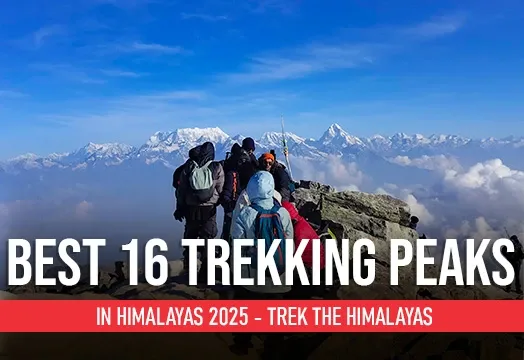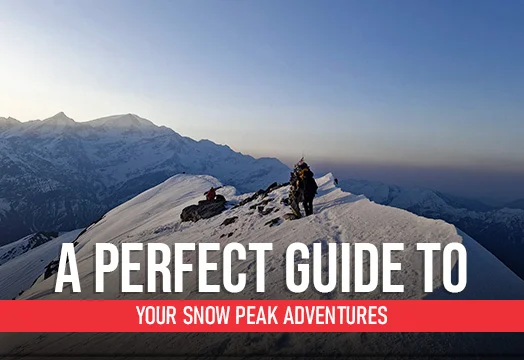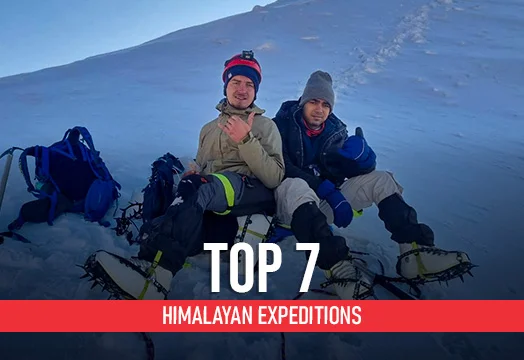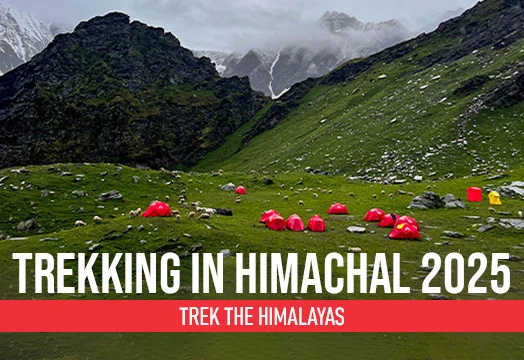Friendship Peak Expedition

Region
Himachal Pradesh | India

Duration
7 Days

Max Altitude
17346 Ft.

Trekking Km
24 KM

Grade
Difficult
Get in Touch with Our Trek Expert
91 8191004846 info@trekthehimalayas.comMonday - Saturday: 10 AM to 09.30 PM (GMT +5:30)
Sunday: 10 AM to 05.30 PM (GMT +5:30)
40000 /Person
- June-2026
- July-2026
- August-2026
- September-2026
- 5% GST will be applicable on Trek Cost and Add-ons
- For non Indians $100 extra trek permit fee
- Services: Manali to Manali | Included Transport.
Add-ons
Offload 2100
- Backpack offload is optional.
- Choose add-ons during booking. If missed, log in and add them later.
- Book off-load at least 10 days before the trek.
- For offline bookings at the base camp, a convenience fee of Rs. 2500 applies.
- Cancellations made before the trip date will receive a full refund.
- + 5% GST will be applicable
- + 5% GST will be applicable
Get in Touch with Our Trek Expert
91 8191004846info@trekthehimalayas.com
Monday - Saturday: 10 AM to 06 PM (GMT +5:30)
Overview
Trek Name: Friendship Peak Expedition
Days: 7
Adventure Type: Trekking
Base Camp: Manali
Season:Summer | Monsoon |
Month:June | July | August | September |
Country: India
Altitude: 17346 Ft.
Grade: Difficult
Rail Head: Chandigarh is the nearest rail head to the base camp
Stay: Camping (Twin sharing)
Food: Meals while on trek (Veg & Eggs)
Location: Himachal Pradesh
Distance: 24 Km.
Trail Type: Summit, Point to point | Scale a peak, Camping at the same location upon returning.
AirPort: Bhuntar, which is 52 km away from Manali
Highlights:
- 5% GST will be applicable on Trek Cost and Add-ons
- For non Indians $100 extra trek permit fee
- Services: Manali to Manali | Included Transport.
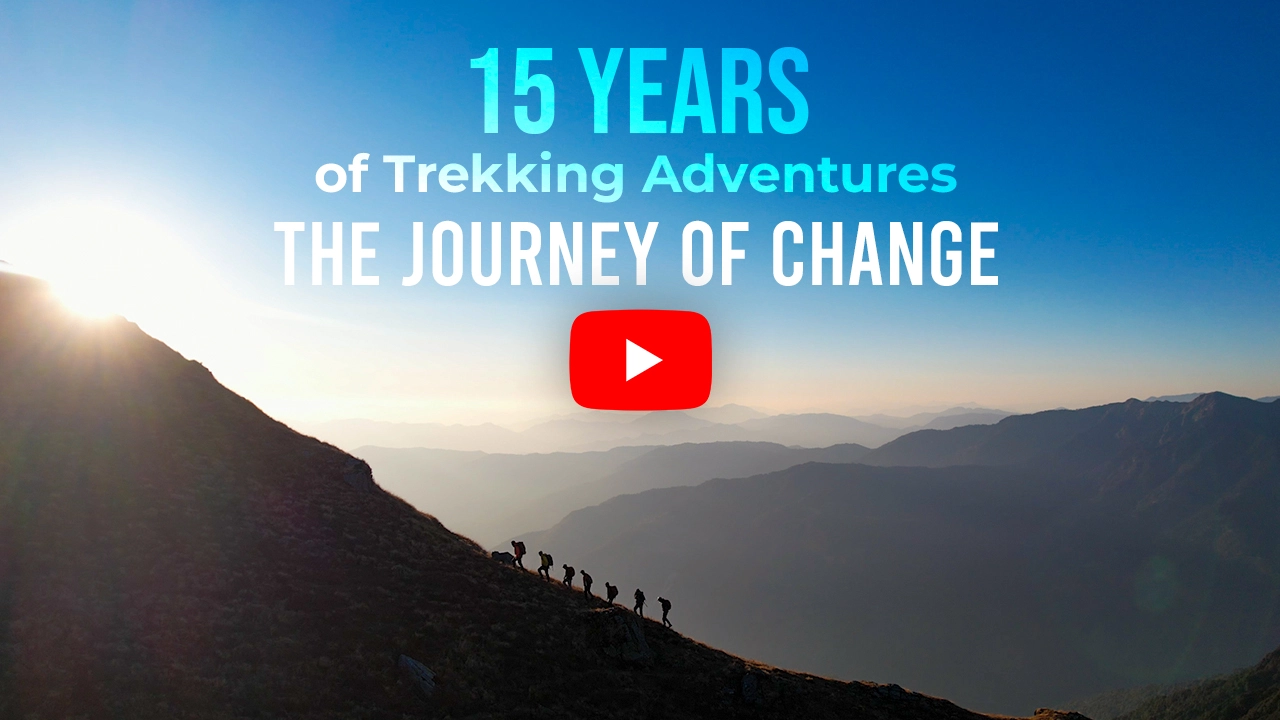
Why is Friendship Peak Expedition a Must Do ?
- The Friendship Peak Expedition or Friendship Peak Trek is an amazing journey through the beautiful landscapes of Himachal, taking you to an impressive height.
- The summit offers an amazing visual treat of sky-touching Himalayan peaks including Deo Tibba, Indrasan, Shitidhar and Hanuman Tibba.
- Watching the sunrise from the peak is an experience of a lifetime! The golden glow over the snow-capped peaks is a sight you will never forget.
- You will experience the thrill of navigating through glaciers, steep slopes and rocky terrain using ice axes, crampons and ropes.
- Every time you pause and look around, you will be amazed by the serene views of peaks and meadows.
- Camping under a sky full of stars in the middle of the Himalayas and waking up to crisp mountain air and breathtaking views is an experience in itself.
- Unlike other crowded treks, Friendship peak trek offers peace and solitude. The only sounds you will hear are the crunch of snow underfoot and the wind howling through the peak.
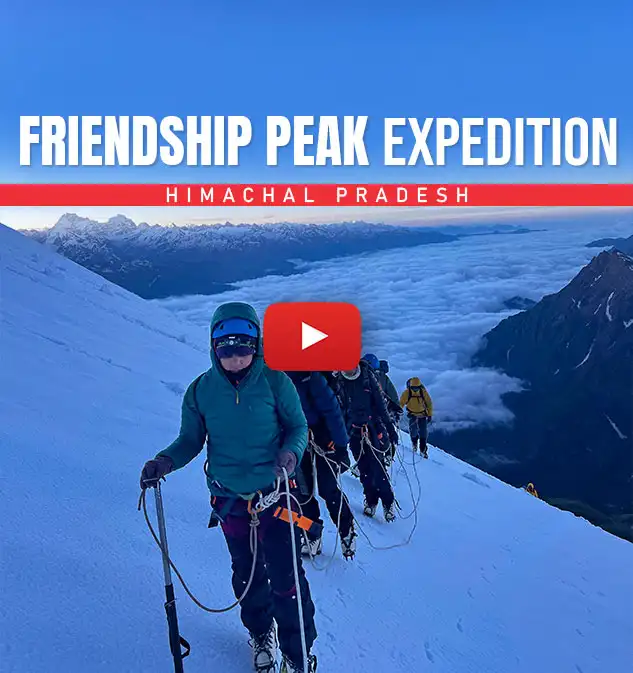
Who Can Participate
- Age Requirement:
- Minimum 16 years
- First-timers are welcome, though prior trekking experience is preferred. Good fitness is a must.
- Fitness Criteria:
- If the trekker wants to carry a backpack then he/she should be able to carry a 10-12 kg backpack. If opt Off-load option then the Trekker should be able to carry 3-5 kg backpack.
- If a trekker's BMI is more or less than the normal range (18-26), please consult our Trek Coordinator before booking.
Friendship Peak Expedition Itinerary
Arrive in Manali
- Altitude: 2000 m/ 6,550 ft.
- Briefing after lunch.
- Sightseeing: Hadimba Devi Temple, Vasishta Kund.
- Stay: Hotel (twin/triple sharing).
The journey starts from Manali, which is a popular tourist destination in Himachal Pradesh. The first day of the trip is reserved for the trekkers to make their way to Manali, where you will check into a hotel and go sightseeing in nearby places. Rest well to prepare for the climb that starts the following day.
Today you will see the popular attractions in Manali like the Hadimba Devi Temple & Vaishist Kund. You can also roam around the Manali Market and shop for souvenirs. Breathe in the fresh mountain air and introduce each other. Document collection and other important procedures for the trek will be done today.
While your body acclimatizes, you will receive a short briefing where you will be updated with the schedule of the upcoming days and some basic do’s and don’ts in the mountains, and how to maintain the sanctity of the mountains by disposing of the wastes responsibly. We are a crusader of the Green Trails Initiative and so we take littering in campsites and the mountains very seriously.
Manali to Dhundi (Drive) to Bakkarthatch (Trek)
- Altitude: Dhundi - 2850 m/ 9350 ft | Bakarthach- 3300 m/ 10,800 ft.
- Drive Distance (Manali - Dhundi): 21 km | 1.5 hrs.
- Trek Distance (Dhundi - Bakarthach): 5 km | 3 hrs approx.
- Grade: Easy trek, gradual ascent.
- Terrain: Walk along Beas River. Trek through coniferous forests of Oak and walnut and meadows.
- Lunch at the campsite.
- Stay in camps.
After a healthy and refreshing breakfast, we will head out on our expedition. The trek starts from Dhundi (21 km away) and it is a 1.5 hrs drive from Manali. From Dhundi we will trek along the beautiful Solang Valley by the banks of the Beas River to reach our campsite in Bakarthach.
Dhundi is a small mountain settlement and the last village in the Solang Valley, a short drive away from Manali. This is the place where the Beas River meets its first tributary after coming out from the Beas Kund. The drive to Dhundi is surrounded by lush greenery and once we reach the village, we will start our trek towards Bakarthach, our first camping spot. On a clear day, you may even see paragliders flying above the valley on your drive to Dhundi.
Today is a relatively easy trek with a gradual incline and an hour into the trek you will begin to see the views of snow-clad mountains. The trek is not very long, about 4 km, and within 3 hours you will reach the Bakarthach campsite. After ascending for about an hour and a half, you will hit some plains and gradual descends, making the walk pleasant and easy.
Soon after 10 minutes, you will come across big boulders and a rocky path and the ascent becomes steeper. Walking for another hour, you will arrive at a clearing, where you can rest for a while. From here, it is an uphill climb through dense forest covers and as you climb upwards, the treeline slowly fades, and crossing a few steep descents you will reach your campsite at Bakarthach.
The Bakarthach Campsite is part of a meadow so you will see a lot of greenery around with glaciers and moraines surrounding the meadow. This spot is also popular pastureland and you can spot shepherds herding their livestock in the meadows during the summer months.
We will pitch our tents in this serene spot and enjoy a hot lunch at the campsite. Bakarthach sometimes receives strong winds and so camps need to be pitched with caution at a stable site, with boulder cover. In the evening you can take small acclimatization walks around the campsite, so that your body can easily accept what is coming next in the following days. Post dinner, retire in your tents for the night.
Bakarthatch to Lady Leg
- Altitude: 3,900 m/ 12,800 ft.
- Trek Distance: 3 km | 3 hrs approx.
Lady Leg, also popularly known as ABC campsite, is an Advanced Base Camp at an altitude of 3900 meters. The trek to Lady Leg is quite strenuous so we will start early in the morning to reach the campsite by afternoon. As you move towards the campsite, the ascend becomes increasingly steeper and you will have to walk over moraine patches to reach the campsite. There will be scree along the path and while you may need to catch your breath once in a while, do not miss the mesmerizing views around you.
Lady Leg is a unique campsite. The shape of the campsite resembles a leg which is how it derived its name. While the distance to the campsite is not much, the climb up is very steep but there’s enough visual stimulation of sky-touching mountain peaks to motivate you on your climb. After a continuous climb for about 3 hrs, you can expect to reach the Lady Leg campsite by lunchtime. From the campsite, you can see stunning views of Deo Tibba, Dhauladhar Range, and Indrasan Peak as well.
To make sure the journey goes safely and smoothly our mountaineering certified experts will give you some knowledge about the technical aspects of trekking that are needed to make the summit. Today you will learn some mountaineering techniques that will be necessary when you make your climb towards the upward patches of the peak and during the summit attempt. The day ends with a delicious meal and you retire in the tents to rest and recuperate for the upcoming summit attempt.
Load ferry to Summit Camp and back to Lady Leg
- Altitude(Summit Camp): 4,750 m/ 14,500 ft.
- Trek Distance: 2 km | 2-3 hrs.
- Acclimatization Day.
- Load Ferry to Summit Camp & back to Lady Leg.
- Breakfast at Lady Leg Campsite.
- Lunch at Summit Camp.
- Stay in camps.
Consider today as an active acclimatization day where you will learn about the concept of load ferry. Load Ferry is a concept adopted for better acclimatization especially when there is an altitude gain. Essentially, the concept of load ferry surmises to ‘climb high and sleep low’ which means you will work at a higher elevation during the day and sleep at a lower elevation to help your body acclimatize.
Today you will collect the equipment, your backpacks, and ration and carry them to Summit Camp. Summit Camp is situated at an altitude of 4,400 meters and you will descend back to the Lady Leg Campsite at 3,900 meters by nightfall. As you move towards Summit Camp the terrain becomes more rugged and you leave behind the greenery into snow and ice.
The slopes are pretty steep and slippery towards the base camp and as you go higher, the snow becomes thicker and thicker. Today’s trek will not only help you acclimatize but you will also get used to walking in snow boots. From the base camp, you will get to see bigger peaks like Hanuman Tibba, Priyadarshini, Indrasan, and Deo Tibba. After spending some time at Summit Camp to adapt to high altitudes, you will descend back to Lady leg campsite and stay the night in your tents.
Move to Summit Camp
- Altitude: 4,750 m/ 15,500 ft.
- Trek Distance: 2 km | 2-3 hrs.
- Move to Summit Camp with necessary items.
- Packed or ready-to-eat food will be provided.
- Get enough rest.
Today’s day is scheduled solely for acclimatization. We will start towards Summit Camp once again and once we reach there, we will spend the day resting and getting used to the higher altitude and also receive some technical training for the summit climb ahead.
We will trek to Summit Camp following the same path as yesterday, albeit it’s a little more comfortable today as we have already lightened some of our weight by transferring most of the things to Summit Camp the previous day, and by now you are also used to walking in your snow boots.
The summit climb is pretty challenging which makes Friendship Peak Expedition a difficult grade trek to prepare you for the expedition. Our team of professional and certified mountaineers will educate you with some technical knowledge and also conduct a technical training session to introduce you to the equipment and teach you the basics of using an ice axe, using the harness and roping up to be able to face the arduous mountain climb.
The final trek to the summit is a difficult one so your body should have as much rest as possible. Drink a lot of water to stay hydrated and sleep through the late afternoon hours and recuperate your body for the summit climb post-midnight.
Summit attempt and back to Lady Leg camp
- Altitude(Friendship Peak): 5,287 m/17,346 ft.
- Trek Distance(Summit camp to Friendship peak): 5 km one way | 8-9 hrs (Both way).
- Trek Distance (Summit camp to Lady leg): 2 km | 1.5 hrs.
- Grade: Difficult.
- Start climbing at 2 am.
- Reach summit by 6 am.
- Reach Lady Leg by 11 am.
- Shoulder to summit vertical zig-zag climb with crevasses.
- Roping-up or fixed rope is required.
- The summit platform is not very wide.
- Stay: In camps (Lady Leg campsite).
This is the most-awaited day as you attempt the summit. This is also the most challenging day of your trekking but also the most rewarding. After giving your body ample time to adapt to the high-altitude conditions and getting adequate rest, we will push towards the summit at around 2 am.
Put your gear on and get ready to embark on a phenomenal adventure! Today you will walk the longest and trekking during the night also adds to the challenge. Head torches are a must in today’s trek. This will be a grueling climb ahead so prepare yourself mentally. The initial part of the climb for the first half-hour is quite manageable and it includes walking over flat snow.
About 40 minutes into the climb it becomes increasingly difficult. Random ice-boulders jut out from the snow beds here and there increasing the difficulty of the climb. You have to maneuver around these boulders repeatedly which can tire you out very quickly unless you have a great deal of physical fitness.
It becomes even more difficult when the snow recedes and the rugged rocks are exposed. Tread along the rocky terrain with crampons and snow boots on is a whole other level of challenge. After about 3 hours of navigating through this difficult terrain, you will hit some smooth slopes. While the slopes may be a little easier on the feet than the exposed rocks but they are in no way less challenging as you have to move onward on a steep incline. You will also need to use the technical skills that you learned here. Always keep the ice axe at your disposal, it will be necessary for this part of the slope.
We will try to reach the summit by 6 am. Magnificent views of Deo Tibba, Hanuman Tibba, Indrasan, etc, await you. The peak view from the top is unlike any other. You get complete unobstructed views of the Himalayan peaks in their snow-ensconced beauty. Celebrate your accomplishment on conquering such a difficult summit but be careful as the summit isn’t too wide. Admire and soak in the glorious views for some time, before we begin our descent to Lady Leg.
The descent can be quite tricky as the ice begins to melt and it's harder to get a grip on the melting ice. Expect to reach Lady Leg campsite by 11 am. We will set up our tents here again and after a delicious dinner, you will head into your camps marking the end of the day.
Lady Leg to Dhundi to Manali
- Trek Distance: 8 km, 4-5 hrs approx.
- Drive Distance: 21 km, 1.5 hrs approx.
- Reach Manali by 3-4 pm.
- Lunch: On the way.
Note: Manali stay is not included in the cost
Day 8: Buffer Day
- Buffer day will be used if the summit cannot be attempted due to any unforeseen circumstances.
- Opting for buffer day is a team decision.
- Recommended to keep a buffer day in your travel plan.
- Buffer day cost is not included in the plan.
- An additional amount will be charged for buffer day on a per day, per person basis.
- If buffer day is not used in the expedition, use it for sightseeing around Manali.
The final day of the trip and the last leg of the trek where you descend to Dhundi and head back to Manali marking the end of an epic journey. Retrace the steps down from Lady Leg to Bakarthach and Dhundi village. We will start early in the morning so that we can reach a lower altitude as quickly as possible. The trek down takes about 4 hours and it will take about an hour to drive back to Manali. Expect to reach Manali by 3 pm and you will have your lunch on the way. The time taken to reach Manali may vary depending on the traffic and road conditions. If you are planning to travel out of Manali on the same day, we recommend booking late-night tickets to account for any potential delay.
Day 8: Buffer Day
Weather in such high-altitude treks cannot be gauged accurately and even with the weather forecast saying something, the weather is always susceptible to drastic changes in such heights, so we keep a buffer day in our plan and recommend you to do the same. The buffer day is used in case the summit is not possible due to some unforeseen circumstances. However, note that the decision to use buffer day or not rests solely on our team and there are extra charges applicable for buffer day per person.
Day-1: Arrive in Manali
- Altitude: 2000 m/ 6,550 ft.
Note: Only hotel stay is included in the cost (sightseeing and food are excluded).
Important note for Non-Indians: Foreign nationals will need a Foreigner Trek permit for the Friendship Peak Expedition. The charge for obtaining the Foreigner Trek permit is $100 per person. The payment will be made directly to the TTH representative upon arrival in Manali on day 1.
Day-2: Manali to Dhundi (Drive) to Bakkarthatch (Trek)
- Altitude: Dhundi - 2850 m/ 9350 ft; Bakarthach- 3300 m/ 10,800 ft .
- Drive Distance (Manali - Dhundi): 21 km | 1 .5 hrs.
- Trek Distance (Dhundi - Bakarthach): 5 km | 3 hrs approx.
Day-3: Bakarthatch to Lady Leg
- Altitude: 3,900 m/ 12,800 ft.
- Trek Distance: 3 km | 3 hrs approx.
Day-4: Load ferry to Summit Camp and back to Lady Leg
- Altitude(Summit Camp): 4,750 m/ 15,500 ft.
- Trek Distance (One way): 2 km | 2-3hrs.
Day-5: Move to Summit Camp
- Altitude(Summit Camp): 4,750 m/ 15,500 ft.
- Trek Distance: 2 km | 2-3 hrs.
Day-6: Summit attempt and back to Lady Leg camp
- Altitude(Friendship Peak): 5,287 m/17,346 ft.
- Trek Distance(Summit camp to Friendship peak): 5 km one way | 8-9 hrs (Both way).
- Trek Distance (Summit camp to Lady leg): 2 km | 1.5 hrs.
Day-7: Lady Leg to Dhundi to Manali
- Trek Distance: 8 km, 4-5 hrs approx.
- Drive Distance: 21 km, 1.5 hrs approx.
Note: Manali stay is not included in the cost
Day 8: Buffer Day
- Buffer day will be used if the summit cannot be attempted due to any unforeseen circumstances.
- Opting for buffer day is a team decision.
- Recommended to keep a buffer day in your travel plan.
- Buffer day cost is not included in the plan.
- An additional amount will be charged for buffer day on a per day, per person basis.
- If buffer day is not used in the expedition, use it for sightseeing around Manali.
Friendship Peak Expedition Graph
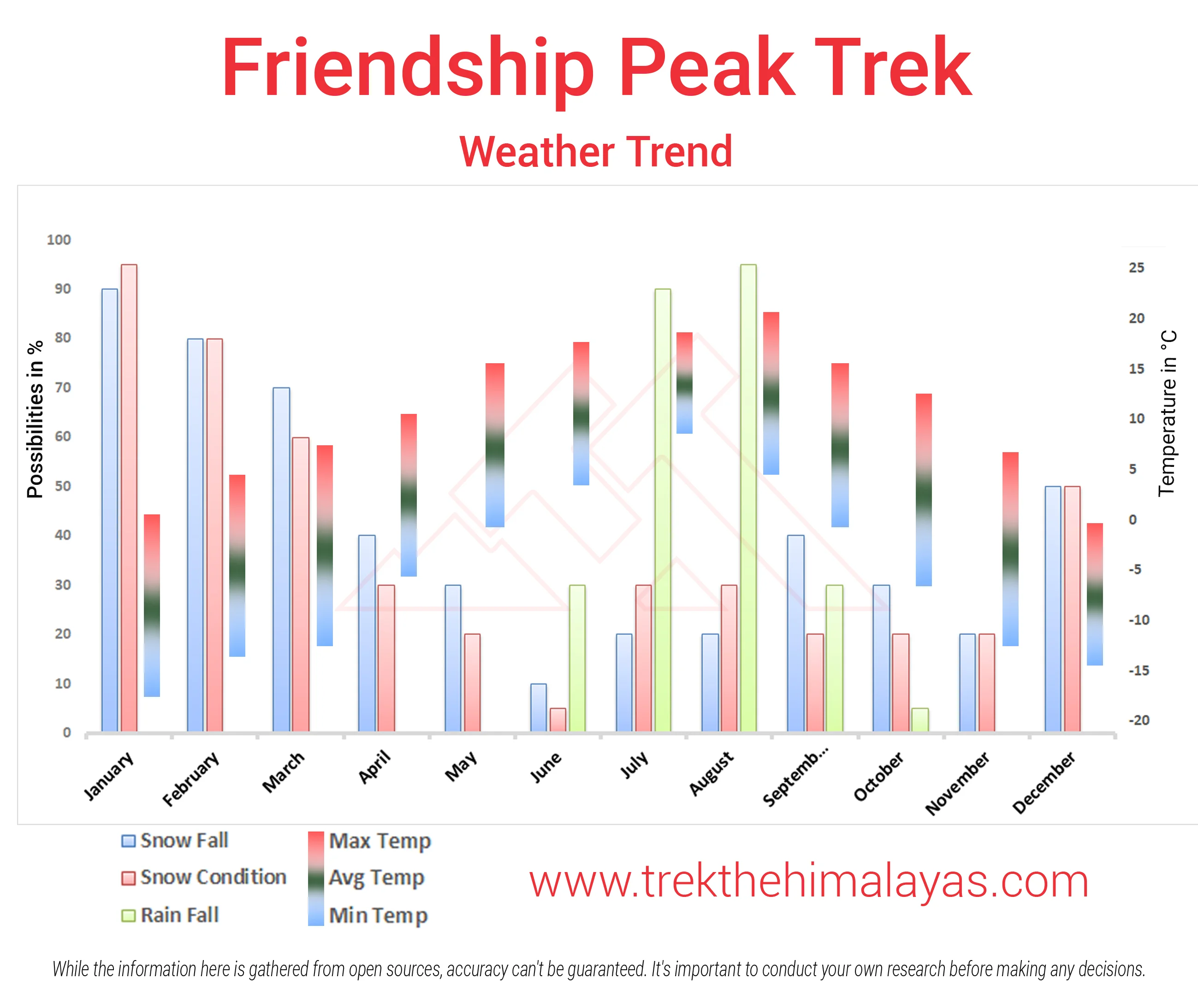
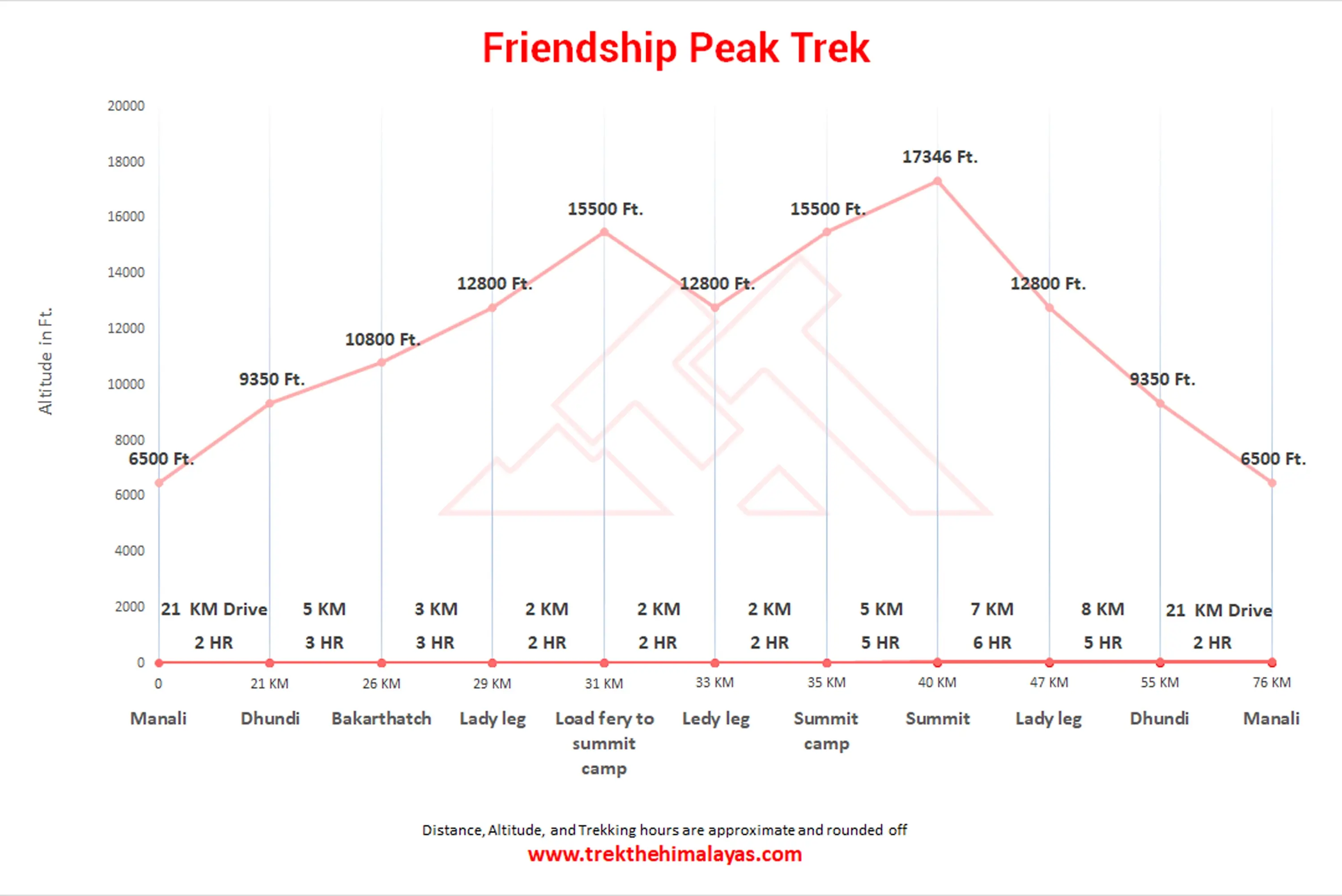
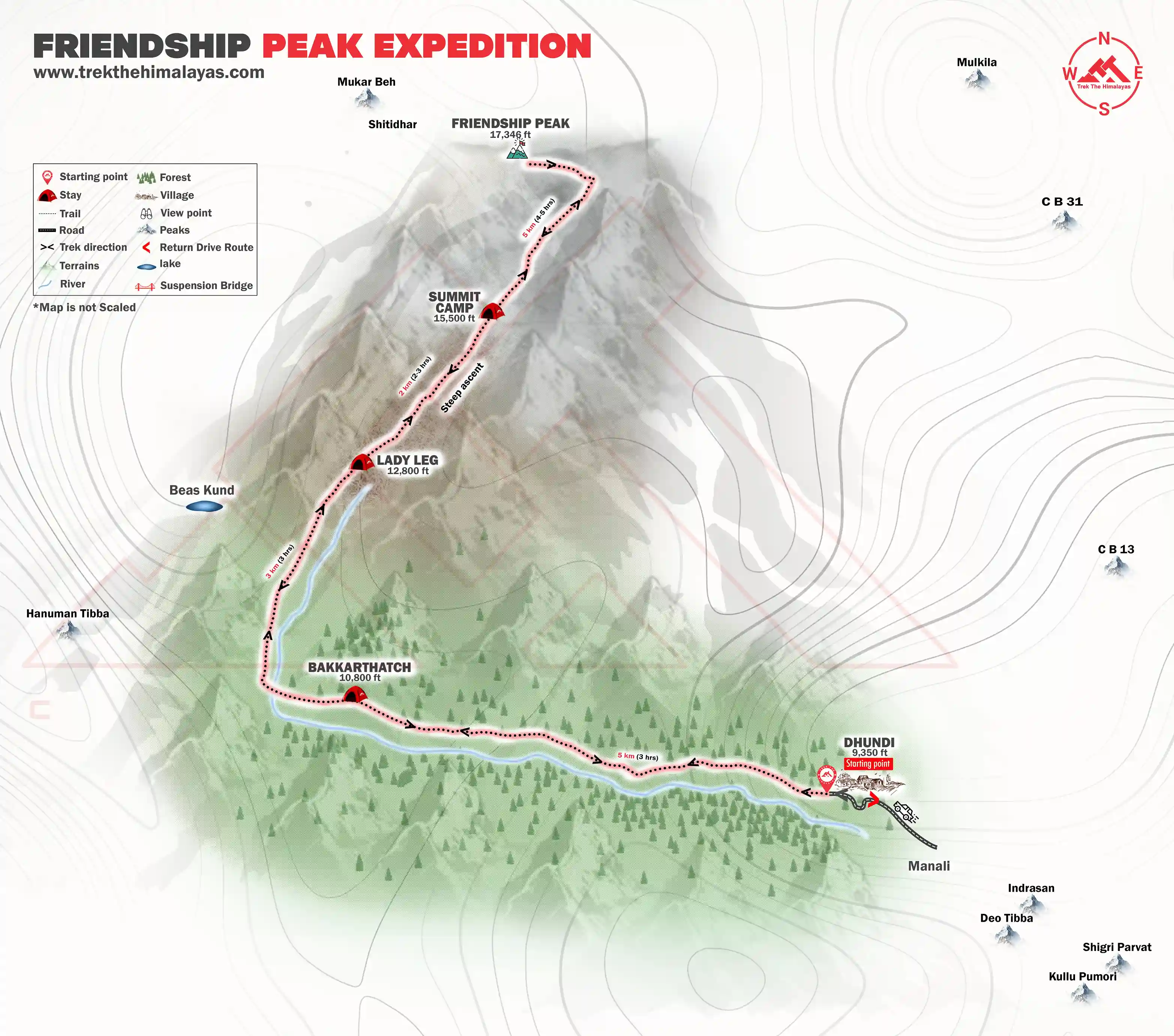
- Pulse rate at rest must be in between (60 to 100 beats per minute).
- Blood Pressure Reading must be in between (DIASTOLIC 75 – 85, SYSTOLIC 100 - 130 mm Hg).
- Respiratory rate at rest must be in between (12 to 20 breaths per minute).
- Should not have Liver and kidney issues.
- Should not have Diabetes Mellitus, Bronchial Asthma, Heart problems, Hypertension, etc.
- No pacemaker implant.
- People with Sinus issues, Epilepsy please contact to trek coordinator before booking the trek.
- If your BMI is not normal, Please contact our Trek coordinator before Trek booking.
Medical & Disclaimer Form (Mandatory Documents) Click here to download Medical & Disclaimer Form
Government employees can avail the benefit of Special Casual Leave (SCL) when they join us for a trekking expedition. As per Pay Commission guidelines, up to 30 days of Special Casual Leave can be availed in a calendar year for trekking or mountaineering expeditions conducted through a registered organisation.
Trek The Himalayas is a registered adventure tour operator with the Indian Mountaineering Foundation (IMF) and the Ministry of Tourism (MoT), making your trek eligible for SCL benefits.
To apply, email us at info@trekthehimalayas at least 20 days before the trek departure date, with the following details:
- Trek name and trek date
- Booking details
- Full name
- Designation
- Department and department address
This benefit is exclusive to Indian Government employees and is applicable only for treks within India.
- Junior trekkers (below 15 years) should have a company of parents/guardians.
- Trekkers between 15 to 18 years can come solo with the disclaimer form signed by parent/guardian.
- Medical & Disclaimer Form (Mandatory Documents) Click here to download Medical & Disclaimer Form
Important Links
- Mandatory Documents to Bring on A Trek Click Here.
- How to pay Add-ons, Submit Medical Forms, and Dietary Preferences Click Here to watch Video
How To Reach
Pick UP Information
- Once you have reached the assembly point of the trek in Manali, TTH will manage the rest of your travel arrangements, if you have opted for TTH's pick-up service, you can select this option during the booking process by adding it as an add-on.
Options to Reach Manali
First, you can arrive at Chandigarh, Delhi, Pathankot, or Bhuntar airport. The journey from these locations to Manali is explained below.
1. Take an overnight bus to Manali from Delhi or Chandigarh, taking a bus from Chandigarh is the most ideal option.
- Chandigarh to Manali Bus: 10 hours.
- Delhi to Manali Bus: 14 hours is hectic and takes more time.
( We always recommend going for the govt. Buses over the private ones outside the bus station as based on the experience we have found that there are very high chances of delay involved with private buses. Also, govt. Buses are always more reliable. Whichever bus you choose, just make sure to reach Manali at 10 am. )
2. You can take a flight to Bhuntar Airport (but we would not recommend it because of the high prices of the flight and very high chances of cancellations), Manali is just a couple of hours away and you can easily get a bus or a private taxi till there. If you do plan to come via Bhuntar, make sure to reach at least a day before the trek starts.
3. You can even come via train, Chandigarh railway station is from where you can get direct buses to Kullu/Kasol/Manali that is 275 km from there and would take an overnight journey. Even in this case, reach a day before at Manali.
( If you prefer to travel independently, you can either take a government bus or book a private cab. Your trek coordinator will provide guidance on how to arrange for the bus or cab booking.)
Drop-Off Information
- The designated drop-off point is the Manali Gov bus stand around 6:30 pm to 7:30 pm .
- Please consider planning your subsequent travel arrangements after 8:00 pm.
- It's highly advisable to keep a buffer day in your travel plan. If the buffer day is not needed, it can be used to explore Manali.
- TTH offers comfortable transportation through Tempo Traveler, Bolero, or equivalent vehicles. If you wish to upgrade your mode of transportation, please contact your trek coordinator for further assistance.
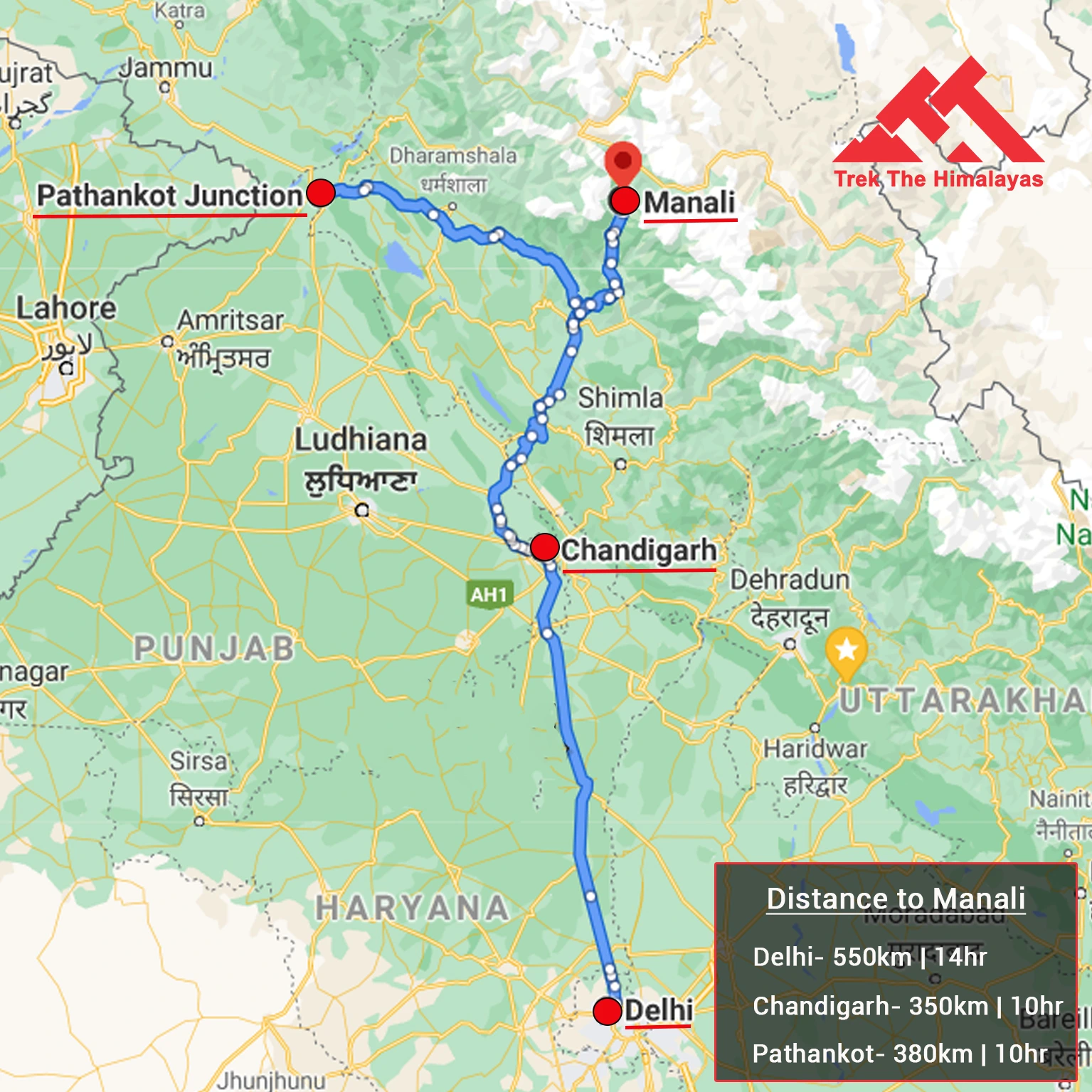
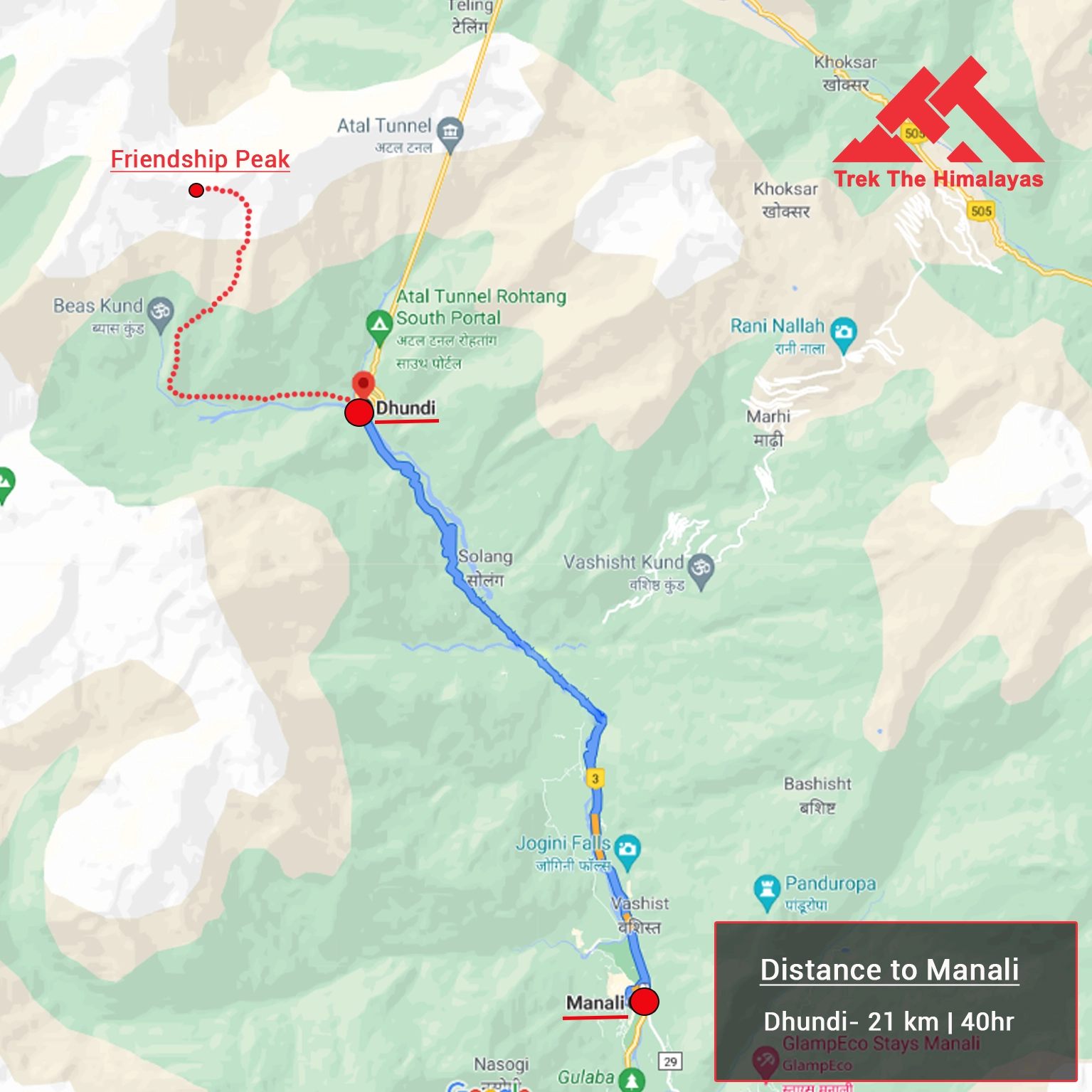
Cost Terms
Inclusion
1. Accommodation (as per the itinerary):
- Hotel on Day 1 (twin/triple sharing basis).
- Camping during the trek (Day2 to Day 6).
2. Meals (Veg + Egg):
- All meals while trekking
- Day 2 Lunch to Day 7 Lunch.
3. Support:
- 1 Versatile base camp manager: handles communication and deploys extra manpower in emergencies.
- 1 Mountaineering & First aid qualified professional trek Leader.
- 1 Experienced high altitude chef.
- Local experienced guides (Number of guides depending on the group size).
- Enough support staff.
4. Trek equipment:
- Sleeping bag, Sleeping liners (if required), Mattress, Utensils.
- 3 men all season trekker tent (twin sharing), Kitchen & Dining tent, Toilet tent.
- Camping stool, Walkie talkie.
- Ropes, Helmet, Ice axe, Harness, Gaiters & Crampon (if required).
5. First aid:
- Medical kit, Stretcher, Oxygen cylinder, Blood pressure monitor, Oximeter, Stethoscope.
6. Transportation (as per the itinerary):
- Manali to Dhundi (Day 2).
- Dhundi to Manali (Day 7).
7. Mules/porters to carry the central luggage.
8. Cloakroom facility available at the base camp for additional luggage.
9. All necessary permits and entry fees, Upto the amount charged for Indian.
10. Services from Manali to Manali
11. Trek Completion Certificate.
Exclusion
- Insurance (For non-Indian Nationals, NRI or OCI card holders).
- Food during the transit.
- Any kind of personal expenses.
- Mule or porter to carry personal luggage.
- Emergency evacuation, hospitalization charge, etc.
- Any extra costs incurred due to extension/change of the itinerary due to natural calamities roadblocks, vehicle breakdown, etc. factors beyond our control
- Anything not specifically mentioned under the head Inclusion.
Things can be provided on demand and availability (participant has to pay extra for these things).
1- Satellite phone/set phone - is a type of mobile phone that connects via radio links via satellites orbiting the Earth instead of terrestrial cell sites like cellphones. Therefore, they can operate in most geographic locations on the Earth's surface.
2- Gamow/PAC HAPO Bag (Portable Hyperbaric Bag) - is a unique, portable hyperbaric chamber for the treatment of acute mountain sickness (AMS), also known as altitude sickness.
3- AEDs (Automated External Defibrillators) - are portable life-saving devices designed to treat people experiencing sudden cardiac arrest, a medical condition in which the heart stops beating suddenly and unexpectedly.
Cancellation Terms
To request a cancellation, please email us at info@trekthehimalayas.com using your registered email ID.
Cancellations prior to 25 days from the start of the Trip
Refund Options
- 5% deduction of trek fee
- 100% trek fee cash voucher for any trip till one year
- Transfer your trek (any trek, any date) to your friend
Cancellation between 24 days and 15 days to the start of the Trip
Refund Options
- 30% deduction of trek fee
- 100% trek fee cash voucher for same trip till one year
- 85% trek fee cash voucher for any trip till one year
- Transfer your trek (same trek, any date) to your friend
Cancellation between 14 days and 10 days to the start of the Trip
Refund Options
- 50% deduction of trek fee
- 80% trek fee cash voucher for same trip till one year
- 70% trek fee cash voucher for any trip till one year
- Book the same trek, in the same season, with any other batch
- Transfer your trek (same trek, any date) to your friend
Cancellation less than 9 days to the start of the trek.
Refund Options
- No cash refund
- 20% trek fee cash voucher for the same trip till one year
- 10% trek fee cash voucher for any trip till one year
- Transfer your trek (same trek, same date) to your friend
- To reschedule a trek (same trek only), a 30 % rescheduling fee of the trek cost will apply.
Cancellation Policy (Emergency Cases):
In case of a death in the immediate family (parents, siblings, spouse, children) or if the trekker is hospitalized (min. 48 hours) or suffers a fracture (leg/arm) within a week before the trek, even if canceled a day before:
90% trek fee refund in cash & 10% as a voucher (valid for 1 year, for any India trek).
Valid documents required. We’re here to support you during tough times.
Note:
- Change of trek batch is dependent on the availability of seats in the batch
- In case of transferring a trek to a friend, he/she should satisfy all the mandatory requirements put forward by TTH
- TTH holds the right to change/cancel the policies, without prior notice
Booking and Payments
- The Participant is responsible for verifying the accuracy of all details, including Trip dates and personal documentation, at the time of booking.
- Payments must be made in accordance with the timelines and instructions provided by TTH. Late payments may result in cancellation of booking without refund.
- In the event of a cash refund, only the portion of the payment made in cash shall be eligible for refund in cash. Any booking made using voucher, discounts, promotional codes, or through any non-cash mode of payment shall not be eligible for a cash refund under any circumstances.
- Refunds, if applicable, shall be processed within 15–30 working days of confirmation.
- All add-on bookings are subject to the respective add-on cancellation policy, and refunds will be processed accordingly.
- Voucher Terms
- This is a non-transferable voucher
- The voucher cannot be merged with any other offer of Trek The Himalayas
- The voucher is valid for Trek booked directly with Trek The Himalayas in India
- To avail the voucher please use your register phone number or e-mail id
- All the other Terms of booking a trek with Trek The Himalayas are applicable to the voucher
Itinerary and Modifications
- TTH reserves the right to modify, shorten, or cancel any part of the Trip due to transportation delays, weather, health emergencies, or other unforeseen circumstances including Force Majeure.
Cancellations and Refunds
- No refunds or vouchers, partial or otherwise, shall be provided for voluntary withdrawal, non-utilisation of services, or removal from the Trip.
- If TTH cancels the Trip before arrival at the designated pick-up point due to unforeseen circumstances or Force Majeure, the Participant may choose from:
- An alternate Trip/date.
- A credit voucher valid for one (1) year.
- Transfer to another Trip, with cost differences payable by the Participant.
- If the Trip is abandoned post-arrival at the designated pick-up point, no cash refund or voucher shall be issued. The Trek Again Policy may apply at TTH’s discretion.
- TTH shall not be liable for any associated travel costs such as flights, accommodation, or visa fees.
Force Majeure
- Events beyond its control including but not limited to earthquakes, landslides, strikes, curfews, war, pandemic, government restrictions, heavy rainfall or snowfall, windstorms, road blockages, trail disruption, or withdrawal of permits, TTH shall not be held liable for any cancellation, delay, or service modification caused by Force Majeure.
Trek Essentials
Rent EquipmentPDF Of Trek Essential Download
| Backpack with rain cover | (50 - 60 ltr) with comfortable shoulder straps |
| Day pack with rain cover | 20 - 30 ltr (If off-load opted) |
| Walking stick | Advisable (At least one) |
| Water Bottle / Hydration pack | 2 bottles of one liter each, People who use hydration pack 1 hydration pack and 1 bottle of one liter, Carry at least one thermos flask. |
| Small size tiffin/lunch box | 1 Nos |
| Snacks | Energy bars, dry fruits, electral/ors |
| Personal Medical Kit | Consult your doctor |
| T-Shirt (Synthetic quick dry) | 1 Full & 2 Half sleeves |
| Fleece T-shirt | 1 Nos |
| Wind stopper / Fleece jacket | 1 Nos |
| Windproof Jacket | 1 Nos |
| Down feather / Hollow jacket | 1 Nos |
| Thermal inner (Upper and Lower) | 1 Pair |
| Trek Pant (Synthetic quick dry) | 2 Nos |
| Wind stopper / Fleece Pant | 1 Nos |
| Waterproof gloves | 1 Pair |
| Fleece / woollen gloves | 1 Pair |
| Poncho / waterproof Jacket and pant | 1 Nos |
| Sunscreen | 1 Nos |
| Moisturiser | 1 Nos |
| Chap-stick / Lip balm | 1 Nos |
| Toothbrush and toothpaste | 1 Nos |
| Toilet paper & Wipes | 1 Nos |
| Soap / hand sanitizers | 1 Nos |
| Antibacterial powder | 1 Nos |
| Quick dry towel | 1 Nos |
| Head torch | 1 Nos. (Avoid Hand torch) |
| Sun Cap | 1 Nos |
| Woolen cap | 1 Nos. |
| Balaclava | 1 Nos. |
| Buff / Neck-gaiters | 1 Synthetic & 1 Woollen |
| Sunglasses | UV with dark side cover, People who wear spectacles - (A)- Use contact lenses | (B)- Photo chromatic glasses |
| Trekking shoes | 1 Pair (Water-resistant, high ankle, good grip) |
| Floaters / flip-flops | 1 Pair |
| Cotton socks | 6 pairs |
| Woollen socks | 1 pairs |
| Gaiters | 1 Pair (TTH provides when required) |
| Micro spikes | 1 Pair (TTH provides when required) |
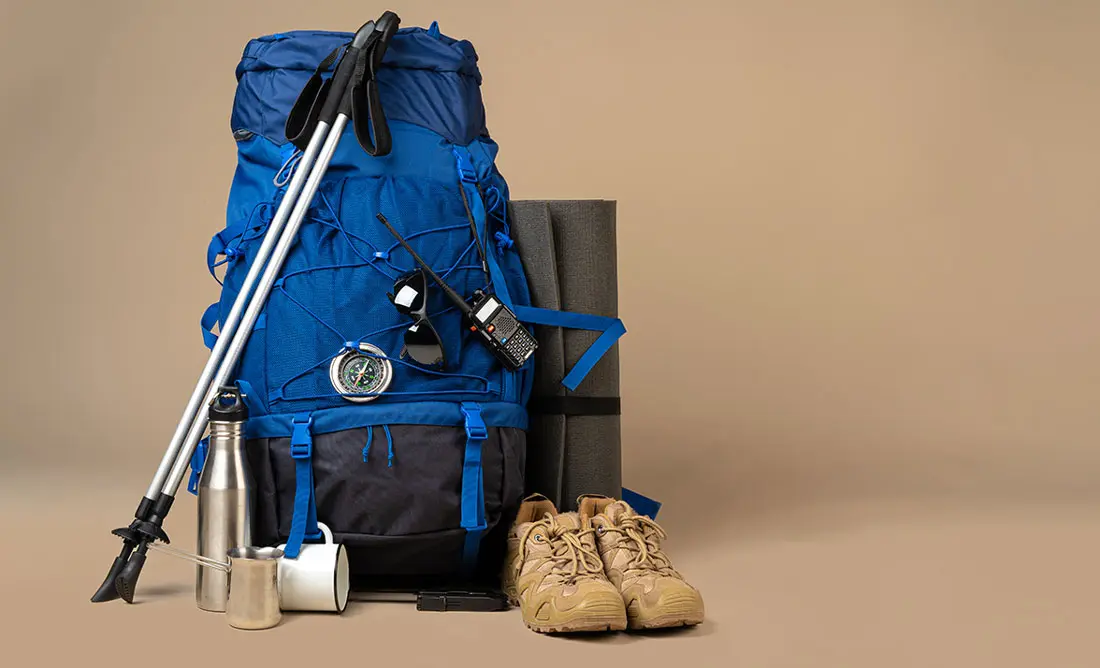
Frequently Asked Questions(FAQ)
To register with TTH, visit our website - www.trekthehimalayas.com and create your account. To create your account you will need to use your email address and fill in all the details, set your unique password and your account is ready to use.
- To book a trek with TTH, you first need to register with us and create an account.
- Choose the trek that you want to do and click on available dates.
- You will land at the login page, fill in the required details.
- Add Participants, choose add-on services click on the Pay now button, choose your preferred payment method, and make the payment. TTH accepts multiple payment options, including credit/debit cards, net banking, and UPI.
- You will receive a confirmation email from TTH with all the necessary details about the trek, including the meeting point, transportation, accommodation, and other important instructions.
- Click Here to watch Video
please send an email to us at info@trekthehimalayas.com or reach out to the numbers provided in the Help and Support section of your Trek Page. We will ensure that your issue is promptly resolved.
To book services such as off-load luggage and transportation, you can find them listed as add-ons. These additional services can be booked at the time of your initial booking. If you miss booking add-ons during the initial reservation, you can log in anytime and easily book 4 days before the departure date add-ons through the platform.
If you have booked the wrong trek or selected the wrong date, don’t worry! You can contact us at +91 9368882322 (Monday to Saturday, 10 AM to 10 PM) or email us at info@trekthehimalayas.com. You can also discuss this with your trek coordinator. Please make sure to inform us at least 10 days before the departure of your trek. Only then can we help you reschedule or arrange another trek for you.
We recommend visiting our "Suggest Me a Trek" page. By filling out the form, our experts will contact you with the best possible trek options based on your preferences and experience level. Alternatively, you can reach out to us via email at info@trekthehimalayas.com or give us a call using the numbers provided on our website for personalized assistance and recommendations.
Family treks differ from regular treks by focusing on ease of difficulty, offering shorter durations for younger participants, Kid-friendly and easily digestible foods, child-friendly activities, maintaining a higher guide ratio for diverse age groups, and implementing additional safety measures for families.
Family Trek with Kids recommendation Only Dayara Bugyal and Chopta Chandrashila Trek.
Minimum age for TTH treks is typically 7 years, though this may vary depending on the specific trek.
Yes, you can take a kids to a high-altitude trek with a parent. Discuss with a trek expert before booking a trek.
- Junior trekkers (below 15 years) should have a company of parents/guardians.
- Trekkers between 15 to 18 years can come solo with the disclaimer form signed by parent/guardian.
- Medical & Disclaimer Form (Mandatory Documents) Click here to download medical and disclaimer form
Physical Fitness: Ensure your child is physically fit. Engage them in regular exercise, outdoor activities, and hikes to build stamina and endurance. Hydration: Emphasize the importance of staying hydrated at high altitudes. Encourage your child to drink water regularly, even if they don't feel thirsty. Proper Nutrition: Provide a well-balanced diet with sufficient carbohydrates for energy and foods rich in iron to prevent altitude sickness. Adequate Sleep: Ensure your child gets enough sleep in the days leading up to the trek. Quality rest is crucial for altitude adaptation. Educate on Altitude Sickness: Teach your child about the symptoms of altitude sickness, such as headache, nausea, and dizziness. Encourage them to communicate any discomfort immediately. Appropriate Clothing and Gear: Dress your child in layers to adjust to changing temperatures. Ensure they have appropriate trekking gear, including sturdy footwear. Positive Mindset: Foster a positive mindset. Encourage your child, and let them know it's okay to take breaks when needed. Medical Check-Up: Schedule a medical check-up before the trek to ensure your child is fit for high-altitude activities. Consult with a healthcare professional about any potential health concerns.
TTH takes special care to provide wholesome and nutritious food for children on treks. Here are some of the foods that are typically served for children:
Breakfast: For breakfast, TTH serves a variety of options like porridge, cornflakes, bread, butter, jam, honey, boiled eggs, omelettes, and pancakes. Children can choose from these options to fuel themselves for the day's trek.
Lunch: For lunch, TTH serves lunch which includes rotis, vegetables, rice, dal, and salad. The rotis are usually made fresh on the trek and are a good source of carbohydrates. The dal and vegetables provide protein and other essential nutrients.
Snacks: TTH provides healthy snacks like fresh fruits, dry fruits, energy bars, cookies, and biscuits to keep the children energized throughout the day.
Dinner: For dinner, TTH serves a hot and wholesome meal which includes soup, rice, dal, vegetables, and a non-vegetarian dish (if requested in advance). Children can also choose from a variety of desserts like custard, jelly, and fruit salad.
Dietary requirements: If a child has any special dietary requirements, TTH can cater to those needs as well. For example, if a child is lactose intolerant or allergic to nuts, the kitchen staff can make arrangements to accommodate those requirements.
Choosing the right trek for a beginner can be a bit overwhelming as there are many factors to consider such as distance, elevation gain, terrain difficulty, weather, and time of year. Here are some tips that can help you choose the right trek for a beginner:
1. Determine fitness level: Assess the fitness level of the beginner to understand their physical capabilities. This will help you select a trek that is challenging but not too difficult.
2. Choose a well-traveled trail: A well-traveled trail will have more amenities such as signposts, water stations, and shelter. It is also safer as there will be other hikers on the trail.
3. Consider the length of the trek: For beginners, it is recommended to start with a shorter trek that can be completed in a day or two. This will help them get acclimatized to trekking and build their confidence.
4. Look for gradual elevation gain: Choose a trek with a gradual elevation gain rather than steep ascents. This will make the trek easier and more enjoyable.
5. Check the weather: Check the weather forecast before selecting a trek. Avoid treks during the monsoon season or winter when the trails can be slippery or dangerous.
6. Research the trail: Read about the trail to get an idea of the terrain, altitude, and difficulty level. This will help you select a trek that is suitable for the beginner.
7. Consult with an expert: If you are unsure about which trek to choose, consult our trek expert Mr. Nitin (+91 70600 59773) between 10 AM to 6 PM (Tuesday - Friday). Mr. Nitin will provide you valuable advice and guidance.
Overall, it is important to choose a trek that is enjoyable, challenging but not too difficult, and suitable for the beginner's fitness level and experience.
It is not recommended for a beginner to choose a difficult Himalayan trek. Trekking in the Himalayas can be physically and mentally challenging, especially if you are not used to the high altitude, steep slopes, and rugged terrain. Choosing a difficult trek without the proper experience, fitness level, and preparation can be dangerous and put you at risk of altitude sickness, injury, and other hazards.
If you are a beginner, it is recommended to start with an easier trek and gradually build up your skills and experience. This will help you understand the challenges of trekking in the Himalayas, and also prepare you physically and mentally for a more difficult trek in the future. It is also important to choose a trek that matches your fitness level, experience, and interest.
There is no specific age limit for a beginner trekker. However, it is important to consider your physical fitness, health condition, and personal interests before embarking on a trek. Trekking in the Himalayas can be physically and mentally demanding, and requires a certain level of physical fitness and endurance.
If you have any pre-existing medical conditions or are above a certain age, it is recommended to consult with a doctor before embarking on a trek. It is also important to listen to your body and take breaks as needed during the trek to prevent exhaustion or injury.
We recommend visiting our "Suggest Me a Trek" page. By filling out the form, our experts will contact you with the best possible trek options based on your preferences and experience level. Alternatively, you can reach out to us via email at info@trekthehimalayas.com or give us a call using the numbers provided on our website for personalized assistance and recommendations.
Yes, you can join the trek. We have fixed departure groups where you can simply book your trek and we will take care of curating a group.
Before you start the trek, it is recommended that you make all the necessary phone calls as during the trek you may or may not receive network coverage, once you come back to the Base Camp, you can reconnect with your family via phone once again. You can share your trek coordinator contact detail with your family members to get the latest updates about your trek batch.
At TTH, we provide wholesome and nutritious meals during the trek. The food is vegetarian and includes a variety of dishes such as rice, dal, vegetables, chapati, paratha, pasta, noodles, and soup. We also offer snacks such as biscuits, and salty, and dry fruits during the trek. Special dietary requirements such as vegan, gluten-free, or Jain food can also be arranged if informed in advance.
If you are allergic to some foods, you need to let us know in advance so that we can make arrangements accordingly.
TTH is a trekking company that prioritizes the safety of all its participants, including women trekkers. We have a comprehensive safety system in place, which includes a dedicated team of experienced and trained trek leaders and support staff who are equipped to handle emergency situations and provide first aid.
TTH also takes specific measures to ensure the safety and comfort of women trekkers. They have a separate tent accommodation for women trekkers, female trek leaders, and support staff. They also provide separate toilet facilities for women and encourage a safe and respectful environment for all trekkers.
Moreover, TTH has a strict policy against any kind of harassment and has a zero-tolerance policy towards such incidents. They have a designated Internal Complaints Committee (ICC) to investigate and address any complaints related to harassment or misconduct. Overall, TTH has a good reputation for safety and responsible trekking practices, and women can feel comfortable and safe while trekking with them.
In case you are the only women in the group, we provide a single sleeping arrangement. Also, during the trek, the trek leader will always remain by your side to provide optimum safety and reassurance.
You can reach out to the trek coordinator to inquire about the number of female trekkers and their respective states who have booked the trek. Please note that the trek coordinator cannot disclose personal details of any trekker. Once you've confirmed your booking, a WhatsApp Group will be created for all the trekkers in your batch. This allows you to connect with fellow trekkers before the trek begins.
While many of our treks are led by female trek leaders, however, it is not possible to know which trek leader is assigned to which group. But nonetheless, whether the trek leader is male or female you can be completely assured of your safety and security with us.
Yes, it is possible to trek with periods. However, it is important to take some extra precautions and preparations to ensure a comfortable and safe trekking experience. Here are some tips that can help you trek during your period:
1. Use menstrual hygiene products that you are comfortable with, such as tampons, pads, or menstrual cups. It is recommended to carry enough supplies for the entire duration of the trek.
2. Pack wet wipes, hand sanitizer, and plastic bags to dispose of used hygiene products.
3. Wear comfortable and breathable clothing that allows for easy movement and reduces friction. Avoid wearing tight or restrictive clothing that can cause discomfort.
4. Carry pain relief medication, such as ibuprofen or acetaminophen, in case of menstrual cramps.
5. Stay hydrated and maintain a balanced diet to support your energy levels and overall health.
6. Take breaks as needed and listen to your body. If you feel uncomfortable or experience any unusual symptoms, seek medical attention immediately. It is also recommended to consult with a doctor before going on a trek during your period, especially if you have a pre-existing medical condition or are taking medication.
By taking necessary precautions and being prepared, you can have a safe and comfortable trekking experience even during your period. We provide proper disposal facilities for sanitary pad disposal during the trek.
We offer three person tents with twin-sharing for optimum comfort. A woman trekker will share a tent with another woman trekker and if you are the only woman in the group, you will be given a single accommodation for your comfort and privacy.
Yes, we do provide gears on rent. You can book it using you TTH account directly.
Mountaineering qualified Experienced and first aid certified Trek Leader, First Aid Certify local guide, Cook, helpers and supporting staff.
People suffering from Bronchitis, Asthma, High blood pressure, Epilepsy (got faints), TB , Heart problem or on higher BMI side are strictly not allowed to go on any Himalayan trek. Apart from this if you had any medical history, please let us know.
No. Alcohol and smoking isn’t allowed while on trek. It is totally misconception that it will keep you warm. Your body need to acclimatize properly and for that eat properly and drink enough water; these things will keep you warm.
Toilet tents provide a convenient solution for answering nature's call in the great outdoors. Dry toilets, in particular, offer a highly sanitary approach. By digging a pit and utilizing mud and a shovel, you can easily cover up your waste. This method ensures cleanliness and hygiene while camping or exploring in the forest.
Remember to pack essential toiletries to complete your outdoor bathroom kit and maintain proper personal hygiene during your adventures. With these practices in place, you can enjoy nature while also respecting it.
Layer Up From Head To Toe
Eat Full Meals, never sleep empty stomach
You can keep warmee (if you’re more susceptible to cold).
Use sleeping bag in right way and don’t leave free space in sleeping bag.
For upper body
– Thermal layer
– T-shirt (full-sleeves)
– Fleece T-shirt (for extreme colds)
– Fleece layer
– Thick Jacket/Down Jacket
– Waterproof or Windproof layer (outermost layer, when it is snowing or raining)
- For Lower Body
– Thermal layer
– Hiking pants (normal) or Winter hiking pants
Based on how warm you feel you can skip any of the above layers. Your outer later should be windproof since it is windy at high altitude.
The idea behind layering is that the more insulation you have the less cold you feel, and instead of wearing a very thick jacket if you wear multiple layers, your body will be better insulated against the cold.
Yes, we provide micro spikes and gaiters, if required.
Mandatory documents: 2 xerox of ID having address (addhar card/driving license), 2 Passport size photographs, hard copy Medical form signed & sealed by doctor, disclaimer form sign by trekker and high altitude insurance.
No. We don’t but we can suggest you good hotel/Stay nearby pick up location.
Yes, trekker must carry 2 water bottles 1 litre each so they can refill it at campsite for drinking and keep themselves hydrate.
You should buy shoes which has these three features –Good grip, Ankle Support and additional water resistant layers. Generally, we advise Quechua Trek 100, MH 500 and MH 100.
No one is forced to go on. There is always enough staff to split the party according to need and regroup later at the camp. Most people have no trouble reaching the highest campsite. If some members decide not to climb the final distance they can wait for the climbers to come back down the same way or take a lateral path to the descent route.
The best time to trek Friendship Peak is during July and August. These months offer the highest chances of a successful summit, with better weather conditions making the trek more manageable. The trails are easier to follow, adding to the overall experience. Monsoon brings its own charm to the trek. The surrounding peaks look fresh and vibrant, and the occasional clouds floating over the mountains add a magical, dreamlike feel to the scenery. If you're planning this trek, aim for these months to enjoy the best of what Friendship Peak has to offer!
The Friendship Peak Expedition is a Difficult Grade Trek, best suited for experienced trekkers. The journey involves navigating steep trails and rugged terrain, which can test your endurance and determination. The summit climb, in particular, is challenging and requires both physical fitness and mental strength. Being at a high altitude adds another layer of difficulty, as there's a risk of altitude sickness. Proper acclimatization, staying hydrated, and being mindful of your health are essential to tackle these challenges.
Friendship Peak is situated in the scenic Kullu Valley of Himachal Pradesh, India. The expedition begins in Manali, a charming hill station that serves as the starting point for the journey.
The altitude of Friendship Peak Expedition is at an altitude of 5,287 meters (17,346 feet) above sea level. From the top, trekkers are rewarded with breathtaking views of the surrounding Himalayan ranges, including the Pir Panjal, the Dhauladhar Range, and other majestic peaks.
To begin the Friendship Peak Expedition, you can fly to Bhuntar Airport in Kullu and then drive to Manali. If you’ve chosen transportation with Trek the Himalayas, they will take you from Manali to Dhundi, the trek’s starting point. From there, the team treks to Bakkarthatch, the first base camp, and continues the journey toward the summit.
Yes, having prior mountaineering experience and a basic understanding of technical climbing skills is essential for attempting the Friendship Peak Expedition. This trek involves challenging terrain and high-altitude conditions that require familiarity with techniques like using ropes, crampons, and ice axes.
You’ll need proper mountaineering gear to ensure safety and success during the expedition. Essential items include climbing boots, crampons for walking on ice, ice axes for support, ropes, harnesses, helmets, warm clothing, gloves, and sunglasses. Your trek operator or guide can provide a detailed list of the required equipment and Trek the Himalayas also offer rental options.
While climbing Friendship Peak involves inherent risks, it can be a safe and rewarding experience with the right preparation and guidance. It’s important to have the required mountaineering skills, good physical fitness, and proper acclimatization to high altitudes. Following safety protocols, using reliable equipment, and trekking with an experienced team or guide significantly reduces risks. Obtaining necessary permits and being informed about the terrain and weather conditions also contribute to a safe and successful climb.
Climbing Friendship Peak comes with certain risks, such as altitude mountain sickness, slips or falls, avalanches, and sudden changes in weather conditions. Altitude sickness is common at high elevations and can cause symptoms like headaches, nausea, and fatigue. Proper acclimatization, hydration, and pacing yourself can help prevent this. Additionally, extreme cold and icy trails require caution and technical knowledge. Trekking with an experienced guide and being aware of your surroundings are crucial for managing these risks.
The Friendship Peak Expedition with Trek the Himalayas is a 7-day journey. It is recommended to keep an extra buffer day in your schedule to accommodate any unforeseen circumstances. The trek starts from Manali and takes you through stunning and iconic locations, including the beautiful Lady Leg. As this is a high-altitude trek, acclimatization days are crucial to ensure a safe and comfortable climb. The journey to the summit is not just adventurous but also incredibly scenic, with breathtaking views at every turn. The summit itself offers spectacular panoramas that will leave you wanting more!
Yes, trekking and camping are integral parts of the Friendship Peak Expedition. You will have the opportunity to camp at picturesque locations such as Bakkarthatch, Lady Leg, and the summit camp. Each campsite offers stunning views of the surrounding peaks and the serene beauty of the Himalayas, making the entire experience truly unforgettable.
It is highly recommended to climb Friendship Peak with an experienced guide. The terrain is challenging, and technical climbing skills are often required to navigate safely. A knowledgeable guide ensures your safety, helps you manage risks, and makes the expedition more enjoyable by sharing insights about the region.
To climb Friendship Peak, you will need permits issued by the Indian Mountaineering Foundation (IMF). If you book your trek with Trek the Himalayas, they will handle the permit process for you, making it hassle-free and convenient.
Some of the most popular mountaineering destinations in India include Stok Kangri in Ladakh, known for its challenging terrain and stunning views; Kang Yatse 1 in Markha Valley, offering a mix of technical climbing and scenic beauty, and Mount Trishul in Uttarakhand, a favorite among mountaineers for its majestic peaks and rich history. These destinations, like Friendship Peak, provide thrilling adventures and unforgettable experiences for mountaineering enthusiasts.
.webp)
.webp)
.webp)
.webp)
.webp)
.webp)
.webp)
.webp)
.webp)
.webp)
